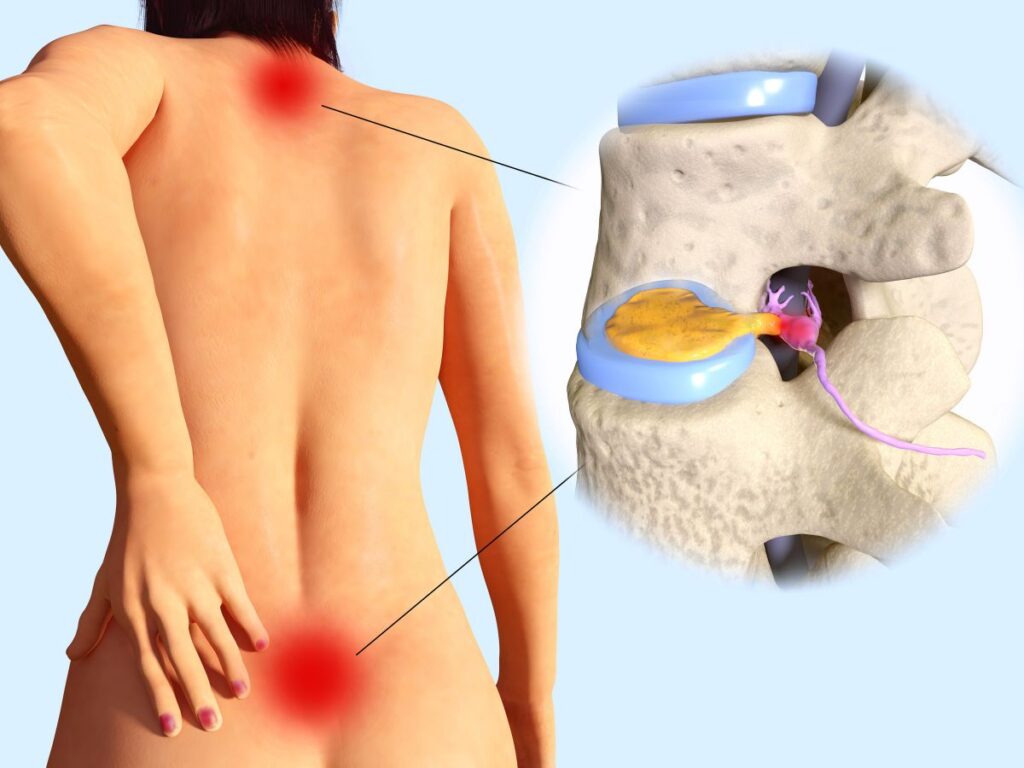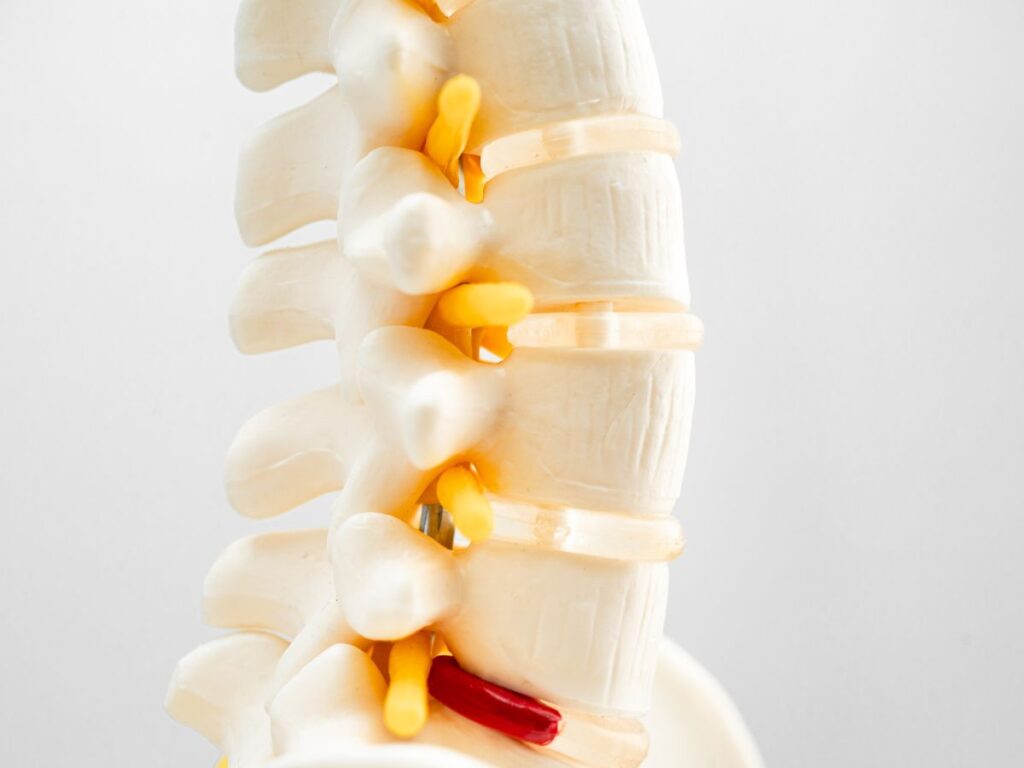Why Decompression Eases Sciatica
Sciatica arises when the sciatic nerve—spanning from the lower spine to the feet—becomes compressed or irritated, often by a bulging disc, narrowed canals, or tight muscles in the pelvis. Spinal decompression helps reverse that pressure by gently stretching vertebrae, reducing disc protrusions and releasing nerve roots from chronic pinching. The traction cycles create negative pressure inside discs, drawing them away from inflamed nerve channels. Coupled with Dr. Elham’s integrative measures, decompression can relieve the radiating leg pain and numbness sciatica inflicts, restoring a more fluid, pain-free stride and curtailing the need for invasive fixes.
Root Causes of Sciatica
Herniated or bulging discs in the lumbar spine are frequent culprits, pressing on nerve roots that converge into the sciatic nerve. A misaligned pelvis or degenerative changes might shrink the openings where nerves exit. The piriformis muscle, if overly tight, can clamp the sciatic nerve in the buttock. Prolonged sitting, weak core muscles, or abrupt injuries further exacerbate nerve friction. Decompression therapy targets the mechanical compression. By systematically pulling and relaxing, it coaxes the disc or joint space open, letting irritated nerves slip free from entrapment, thus offering sciatica sufferers a direct line to relief.
The Decompression Session
On the decompression table, a harness secures your hips while a motor applies gentle traction to the lower spine, then releases. These repetitive pulls and rests reduce spinal disc pressure in measured increments. Dr. Elham adjusts angles to isolate the segments impacting sciatica, ensuring enough stretch to relieve nerve contact without provoking new aches. Sessions typically last 15-30 minutes, repeated over several weeks. Many find the cyclical motion soothing—akin to a relaxed spine stretch. With each cycle, the nerve root tension gradually diminishes, fostering healing instead of perpetual inflammation.
Dr. Elham’s Complementary Care
Though decompression addresses a major piece—namely disc or joint space—other factors matter too. Dr. Elham aligns the pelvis or sacrum if subluxations intensify sciatic nerve compression. In some cases, specific exercises loosen the piriformis or hip flexors that exacerbate nerve aggravation. If stress amplifies muscle tension, simple relaxation drills reduce re-tightening. This synergy ensures traction gains remain intact, preventing minor misalignments from pulling the nerve back into a jam. Over time, the unified approach yields stronger backs and calmer nerves, pushing sciatica flare-ups to the periphery.
Why Decompression Aids Sciatica
Spinal decompression therapy for sciatica highlights these core benefits:
- Less Disc or Joint Pressure: Each traction cycle unloads the nerve root, soothing radiating leg pain.
- Improved Circulation: The negative pressure effect draws blood and nutrients into the disc region, fostering nerve recovery.
- Avoiding Invasive Measures: Many circumvent surgery or epidural injections by rehabilitating the spine’s natural spacing.
- Gentle, Repetitive Relief: The method rarely triggers new discomfort, offering a calm route to nerve decompression.
- Supports Spinal Alignment: Decompression sets the stage for Dr. Elham’s adjustments, locking in nerve freedom.
Progress accumulates session by session, letting sciatica symptoms abate gradually and with less risk compared to surgical interventions.
Extending Results Between Visits
After traction therapy, Dr. Elham usually recommends posture checks—standing tall, keeping hips and shoulders balanced—to minimize nerve tension. Short stretching routines, focusing on the hamstrings or piriformis, forestall muscle spasm. Core exercises—like planks or supine leg raises—bolster spinal stability so the nerve doesn’t re-bind. For sitting, a lumbar roll or ergonomic seat keeps the pelvis neutral, preventing disc compression. Light daily walks maintain the improved spacing gleaned from decompression. By combining these strategies, you protect the nerve root from slipping back into the same impingement patterns that generated sciatica pain.
Scotia and Activity Barriers
Sciatica can derail everyday routines—like climbing stairs, leaning to tie shoes, or standing for extended durations. Decompression peels away the mechanical pinch behind these aches, letting you reintroduce normal movements gradually. Dr. Elham’s posture or micro-break advice ensures you avoid re-irritating the nerve with repetitive bending or twisting. Athletes might adapt training regimens to reduce high-impact stress, focusing on form and supportive stretching. Over multiple sessions, sciatica-induced fear dissolves as nerve friction dwindles, reinstating confidence to stride, lift, or simply walk without anticipating shooting leg pains.
Neglecting Sciatic Pain: The Risks
Unresolved nerve compression can cement sciatica into a chronic condition, leading to constant numbness, muscle weakness, or foot drop. The body may adopt compensatory postures, triggering further spinal misalignments or knee and hip strain. Sleep disruptions drain energy, fueling irritability or mental fatigue. In advanced cases, disc or joint damage may worsen, ultimately requiring complicated surgeries. By leveraging spinal decompression early, you circumvent these outcomes, sparing nerve tissues from lengthy compression and safeguarding your spine’s long-term health.
Life in a Session
Patients typically lie face-up or face-down on the decompression table—Dr. Elham selects the posture best suited to the sciatica source. A harness around the hips anchors them to the lower table segment while the upper body remains on a stationary portion. The motor then applies tension in set intervals, gently elongating the spine, then easing off. You might sense a pleasant stretch in the low back or hips, rarely painful. After about 20 minutes, the session ends, and Dr. Elham may perform a mild adjustment or propose a short walking routine to stabilize. Over successive appointments, nerve irritation ebbs away, culminating in steadier comfort throughout the day.
Stepping Past Sciatic Pain
Spinal decompression for sciatica nerve pain sets the foundation for nerve recovery. Once vertebral pressure subsides, nerve roots can heal and normal leg sensations resume. Dr. Elham’s integrative approach cements these gains—using posture corrections, mild strength exercises, or chiropractic alignments to keep the nerve corridor open. Over weeks of traction sessions, many find the radiating pain, pins-and-needles, or numbness recede. The daily relief fosters confidence to bend, walk, or even jog without dread of nerve twinges. In essence, decompression therapy paves a road back to fluid motion and an active lifestyle, anchored by stable, irritation-free sciatic nerve function.






